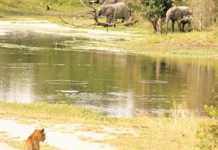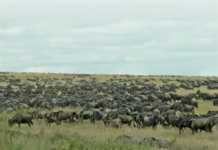Habitat designer and biologist Breedlove says the bulk of a landowner’s management focus must go to the top 25cm below-ground soil layer as most land value is generated from there to 50cm above ground. The below-ground and above-ground areas should be treated as separate, distinct “crops” or habitat types. Crops will grow best when the top 25cm below-ground soil layer is optimised.
Returning the pre-European tilth
The top 25cm below-ground soil layer must be returned to the tilth it had before European colonisation. The pre-European natural system tilth was created and maintained by animals, plant roots and their interactions. Some 300 years of poor management has eliminated much to most of this free service that yielded high productivity.
In the near term, climate change will affect remaining conditions – almost certainly for the worse. he animals that create and maintain this tilth are, to a large extent, microscopic or near microscopic. The mycorrhizae, which are root fungi, must receive the most attention.
They have either a species specific or more general relationship to vegetation species growing above ground, and are critical elements for achieving natural system potential. Mycorrhizae are the primary transport means for water and nutrients, particularly phosphorus, to plant roots from the soil. Their hyphae extend into and extract from soil spaces that are not accessed by fine plant roots.
Worldwide their use holds rapidly increasing importance for productivity, diversity and sustainability. They can be cultivated and introduced to the land. he tilth can be obtained at almost no cost. initial setup consists of a 4ha exclosure with the necessary “ingredients”. “An exclosure is a kind of forced savings plan. If you build it, put a few things – such as your best grasses – into it and don’t check up on it too often,” says Breedlove. “It’s surprising how well it performs in creating diversity. Once things start working inside the fence, the benefits will spread to outside the fence too.”
Look after burrowers
Shift the focus to the larger animals, the burrowing creatures. Certain ones are more valuable than others in re-establishing the soil tilth necessary for land optimisation. For tilth, look at earthworms and the “little hairies”. here are three types of earthworms. first group lives in litter above ground, the second group in the near-surface below-ground environment and the third in the deeper layers, and burrowing vertically. All are associated with significant improvements in soil productivity and carrying capacity.
Now add the little hairies. They are the many species of smaller mammals that dig and burrow near the soil surface. If mycorrhizae and other soil microflora and microfauna can be seen as one management focus, then the little hairies should be considered as the other group. They are also important prey species for larger animals of more typical interest to visitors. They will be necessary for achieving optimal populations of higher-level animals.
The little hairies can be significant transporters of mycorrhizae. They have been shown to be important for recolonisation of mycorrhizae in disturbed areas because they carry fungi and spores in their fur. But the mixing of soil with its attendant loosening and aeration is their most important land optimisation function.
Create points-of-spread Propagation of the improved conditions will be slow, the ecotone extending a few metres per year, but it’s free. “Use points-of-spread as disturbance-free starting points for the re-establishment of this mix of species, conditions and functions,” Breedlove says. “Build an exclosure to protect each point-of-spread. Put these at fence junctions to save on fencing costs and remember that points-of-spread need to be protected from predators, fire, grazers and overuse.”
Pollinator diversity
The above-ground emphasis must be placed on pollinator diversity and specifically on non-honeybee pollinator diversity and density. This shift from a focus on vegetation to a focus on non-honeybee pollinators must not be ignored. The right vegetation will attract the right pollinators. “If you don’t optimise the pollinators, you’ll never optimise the vegetation,” Breedlove says.
Non-honeybee pollinators particularly important include the leaf-cutting and mason bees, other species in the honeybee family, and the stingless or mopane bees. There are other groups and many species of interest including wasps and flies. “An interest in one or more of these groups, particularly the soil and vegetation nesting species, will get you thinking and managing differently,” Breedlove says. “The non-honeybee pollinators are responsible for much of the seed set, biomass production, the ultimate diversity of your pastures and veld, and the income stream that results from it. If you don’t do this, you’ll see a major drop in native honeybee populations due to varroa and the tracheal mite.
Non-honeybee pollinators are so small you probably won’t notice them until you look for them,” Breedlove says. “After that you will become habitually aware of their presence or absence.” They occur as adults only during the part of the year when the species of flowers with which they are associated are in bloom. Very few can be considered generalist pollinators. Many overwinter either in holes in the ground or in stems of non-crop vegetation. “You probably wipe out many with your “management”, assuring they can’t recover,” Breedlove says. Non-honeybee pollinators are linked to significant increases in yield of conventional field crops and are becoming a noteworthy management focus in several intensely cultivated agricultural portions of the world.
Soil organic carbon
Lastly, one simple and effective means of measuring success is required. Soil organic carbon can be determined in a lab and should be tested in a few locations and at different points in time to have some baseline data. However, the depth of the dark, near-surface layer of the soil and its colour are good indicators of soil organic carbon. A soil core analysis is very easy to take and depth to colour change are easy to measure using a standard soil colour chart. When taking soil samples, the deeper the depth and the darker the colour, the better.
“Now you have a basic land management system that will improve on its own if you don’t beat it too hard,” Breedlove says. “Small mammal burrows, earthworm castings and non-honeybee pollinators are easy to track. You will notice when they appear in new locations and estimate their rate of spread. The improvement in vegetation diversity and bulk is also easy to see. So to keep tabs on progress, keep track of the above-ground plant vigour, biomass and diversity.” Next week we will discuss what happens when animals and humans meet. Contact Ben Breedlove on (012) 343 5201 or e-mail [email protected]. |FW












